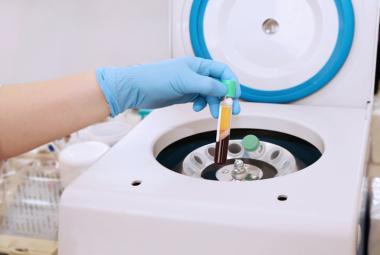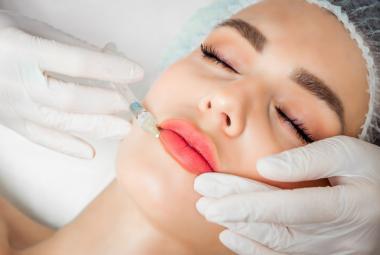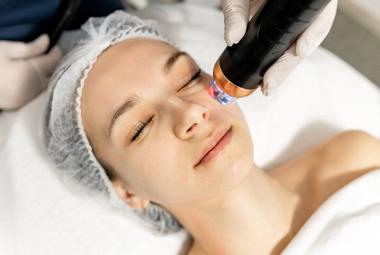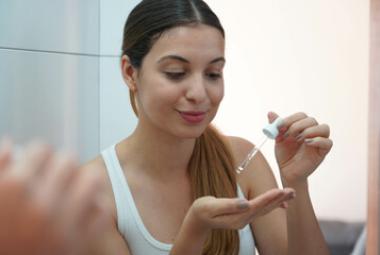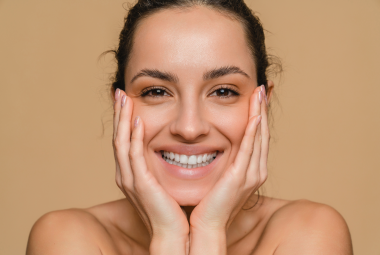Breastfeeding mothers often wonder about the safety of Botox injections. In the past two years, research has expanded on this topic allowing mothers and providers to make more informed decisions. While research on this topic is limited, current evidence suggests that the risk of Botox entering breast milk and affecting a breastfed baby is extremely low. The decision to use Botox while breastfeeding should be made with your healthcare provider, considering your personal comfort, medical need, risks to your baby, and the benefits of breastfeeding.
What is Botox?1
Botox, also known as onabotulinumtoxinA, is a purified form of botulinum toxin, a neurotoxic protein produced by the bacterium Clostridium botulinum. It works by temporarily relaxing muscles through the inhibition of acetylcholine, the neurotransmitter responsible for triggering muscle contractions. By blocking this signal, Botox effectively reduces unwanted muscle activity in both medical and cosmetic treatments. It is FDA-approved for several indications, including:
- Facial wrinkles
- Chronic migraines
- Muscle spasms
- Excessive sweating
- Overactive bladder
- Incontinence
Despite its wide usage, questions about its safety during breastfeeding remain due to limited data.
Adult Side Effects and Systemic Absorption1,2
The side effects of Botox injections vary depending on the injection site and dosage. The most common reactions include headaches, eyelid drooping, or swelling at the injection site. Despite these potential side effects, research shows that Botox generally remains localized and has minimal systemic absorption.
In rare cases, Botox can spread beyond the injection area, leading to more serious symptoms such as difficulty breathing or trouble swallowing. These severe reactions—sometimes referred to as Botox "poisoning"—are typically linked to improper administration or the use of a counterfeit or contaminated product, not to standard, properly dosed treatments.
Botox versus Botulism
Botox is derived from botulinum toxin, a potent neurotoxin produced by the bacterium Clostridium botulinum. In its natural form, this toxin is responsible for botulism, a serious illness characterized by gastrointestinal distress, muscle weakness, and, in severe cases, paralysis. The bacterium exists in the environment as spores, which can survive in dormant form and germinate under the right conditions to produce active toxin.
However, the botulinum toxin used in medical and cosmetic Botox treatments is a purified, inactive form administered in small, controlled doses. It contains no live bacteria or spores. When used properly, Botox remains localized at the injection site with minimal systemic absorption, and the likelihood of severe side effects—particularly in adults—is extremely low.
In contrast, infant botulism can occur when spores are ingested and germinate in the immature gut, producing toxin internally. A common source of such spores is honey, which is why it is not recommended for infants under 12 months. (See our article on Breastfeeding and Honey for more information.)
Despite the shared origin with botulism, Botox poses a far lower risk. It is not expected to pass into breast milk, and no live bacteria or spores are present in the product. Supporting this, two reported cases of breastfeeding mothers with severe botulism showed no detectable botulinum toxin in their breast milk, and the infants in both cases remained unaffected. These findings further reinforce the conclusion that maternal use of Botox carries an extremely low risk to nursing infants.
Current Research on Botox and Breastfeeding (As of April 2025)
Hudson, Wilson, Lieberman, Mittelman and Parikh 3 (2024)
Hudson et al. studied breast milk samples from four women after they received 40–92 units (~2-5 ng) of facial Botox (intramuscular injection).
- Findings:
- Two of the four participants had no detectable Botox in their milk.
- The other two participants had Botox milk concentrations ranging from 85 to 747 pg/mL (0.085–0.747 ng/mL) using an ELISA assay
- These levels did not correlate with maternal dose or time post-injection.
Gu, Xu, Koviazina, Tan, Zheng, Kappes, Kotsifaki, Shen and Tsigkou 4 (2025)
Gu et al. analyzed breast milk samples from three women who received 64 units (~3 ng) of facial Botox.
- Findings:
- The maximum Botox milk concentration detected was 167 pg/mL (0.0167 ng/mL) using an ELISA assay
- Again, there was no clear relationship between maternal dose or time post-injection and the levels found in milk.
Other methods were used: Mass Spectrometry detected no Botox, other methods (Raman spectrometry and various western blots) noted trace presence of Botox over a year.
So what do these numbers mean?
Good question. Injected amounts of botulinum toxin are tiny (1 ng per ml is 1 part per billion…all milk levels were below that). Let’s make some comparisons.
- Deadly intravenous doses of botulinum toxin5 for a 10 kg (22 lb) baby would be about ~10-20 ng (even then, we would expect 50% mortality). Using these numbers, even if the entire maternal dose (max 5 ng in these studies) was directly injected into a baby’s bloodstream, it probably wouldn’t be fatal.
- There is a big difference in direct injection and oral consumption of molecules. Stomach acid will digest the toxin, preventing it from getting into an infant’s bloodstream. Purified botulinum toxin seems to have an especially difficult time entering the bloodstream if administered orally.6 In cases of foodborne botulism illness, other proteins are required to protect the botulinum toxin from stomach acid and cause systemic infection.6
That said, we have trouble interpreting the findings of these studies. Using an example within the reported ranges in the studies, if there was 0.1 ng/ml of Botox in milk and we assume the standard infant milk intake of 150 ml/kg/day, an infant would get 15 ng/kg of Botox per day from milk. Wait, what? … That is more than the maternal injected dose. This makes no sense, and we have no good explanation. Our best guess is that there was an issue with the quantification of Botox in milk. These studies used ELISA assays, which are notoriously challenging in milk. The multiple methods used by Gu et al does give us some indication that at least some Botox persists in milk for a long time, but we don’t have a good idea of how much.
We’re still getting to the bottom of this. Until then, Botox is still unlikely to cause harm via breast milk. We’re aware of many moms who have made this choice without observing infant harm. Our anecdotal data isn’t the degree of information we would like to use…so we’ll keep an eye on it.
Practical Recommendations
- No Need to Pump and Dump: Current evidence suggests no precautions, such as pumping and discarding breast milk, are necessary after Botox injections.
Monitor Your Baby: While not expected, symptoms like lethargy, droopy eyelids, or swallowing difficulties in infants should prompt immediate medical attention.
Alternatives to Botox
If you’re hesitant about Botox while breastfeeding, consider these alternatives:
- For Wrinkles:
- Hyaluronic acid serums for hydration and plumping
- Adequate hydration and a diet rich in antioxidants
- Sunscreen, sunglasses, and avoiding tanning beds
- For Migraines or Muscle Issues:
- Breastfeeding-safe preventative and abortive medications (See our recommendations here)
Massage or gentle stretches
Not-Quite-Botox (Other botulinum toxin products)
There are products similar to Botox (onabotulinumtoxinA) that include other formulations of botulinum toxin type A and type B. Alternatives include:
- AbobotulinumtoxinA (Dysport)
- IncobotulinumtoxinA (Xeomin)
- PrabotulinumtoxinA (Jeuveau)
- DaxibotulinumtoxinA (Daxxify)
- RimabotulinumtoxinB (Myobloc)
These products have varying potencies, dosing regimens, and clinical applications, but they all function in the same way as Botox (inhibiting acetylcholine release at the neuromuscular junction), leading to muscle relaxation. These have not been studied during breastfeeding.
Conclusion
Research is inconclusive about how much Botox gets into milk, but its risk to a breastfed infant is small. Ultimately, whether to receive Botox while breastfeeding is a personal decision made in consultation with your doctor. We commend your dedication to ensuring the safety of your baby while pursuing your own health and well-being.
Nichole Campbell, MSN, APRN, NP-C
Katie Boatler, RN, BSN
Kaytlin Krutsch, PhD, PharmD, MBA, BCPS
References:
1. BOTOX Cosmetic (onabotulinum toxin A) [package insert] (Allergan) (2021).
2. Bai L, Peng X, Liu Y, et al. Clinical analysis of 86 botulism cases caused by cosmetic injection of botulinum toxin (BoNT). Medicine (Baltimore). Aug 2018;97(34):e10659. doi:10.1097/MD.0000000000010659
3. Hudson C, Wilson P, Lieberman D, Mittelman H, Parikh S. Analysis of Breast Milk Samples in Lactating Women After Undergoing Botulinum Toxin Injections for Facial Rejuvenation: A Pilot Study. Facial Plast Surg Aesthet Med. Sep-Oct 2024;26(5):523-526. doi:10.1089/fpsam.2023.0326
4. Gu H, Xu Z, Koviazina R, et al. Detection of nontoxic BoNT/A levels in post-facial Botox injection breastmilk. Original Research. Frontiers in Drug Safety and Regulation. 2025-January-06 2025;Volume 4 - 2024doi:10.3389/fdsfr.2024.1480515
5. Lin L, Olson ME, Eubanks LM, Janda KD. Strategies to Counteract Botulinum Neurotoxin A: Nature's Deadliest Biomolecule. Acc Chem Res. Aug 20 2019;52(8):2322-2331. doi:10.1021/acs.accounts.9b00261
6. Maksymowych AB, Reinhard M, Malizio CJ, Goodnough MC, Johnson EA, Simpson LL. Pure botulinum neurotoxin is absorbed from the stomach and small intestine and produces peripheral neuromuscular blockade. Infect Immun. Sep 1999;67(9):4708-12. doi:10.1128/IAI.67.9.4708-4712.1999
7. Douthirt C. An outbreak of botulism in Tucumcari, New Mexico. Southwest Med. 1938;51(3)
8. Middaugh J. Botulism and breast milk. N Engl J Med. Feb 9 1978;298(6):343.
Additional Reading:
- Frevert J. Content of botulinum neurotoxin in Botox®/Vistabel®, Dysport®/Azzalure®, and Xeomin®/Bocouture®. Drugs R D. 2010;10(2):67-73. doi:10.2165/11584780-000000000-00000
- Tang-Liu DD, Aoki KR, Dolly JO, de Paiva A, Houchen TL, Chasseaud LF, Webber C. Intramuscular injection of 125I-botulinum neurotoxin-complex versus 125I-botulinum-free neurotoxin: time course of tissue distribution. Toxicon. 2003 Oct;42(5):461-9. doi: 10.1016/s0041-0101(03)00196-x. PMID: 14529727.
- Lee KC, Korgavkar K, Dufresne RG Jr, Higgins HW 2nd. Safety of cosmetic dermatologic procedures during pregnancy. Dermatol Surg. 2013 Nov;39(11):1573-86. doi: 10.1111/dsu.12322. Epub 2013 Oct 29. PMID: 24164677.
- Trivedi MK, Kroumpouzos G, Murase JE. A review of the safety of cosmetic procedures during pregnancy and lactation. Int J Womens Dermatol. 2017;3(1):6-10. Published 2017 Feb 27. doi:10.1016/j.ijwd.2017.01.005
- Bozzo P, Chua-Gocheco A, Einarson A. Safety of skin care products during pregnancy. Can Fam Physician. 2011;57(6):665-667.


